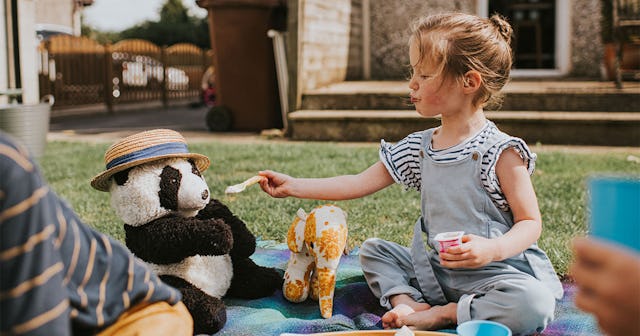Don't Force It: This Is How You Really Teach Your Kid To Share (And Be Patient)

“Sorry, Kylie, Mommy’s using the yellow crayon right now.”
My two-and-a-half-year-old niece withdrew her hand, a confused and somewhat hurt expression on her face. I stared at my sister incredulously. She really wasn’t going to give her kid the stupid crayon? That is my precious, perfect baby niece. Give her the dang crayon, you psychopath.
My own baby was only just toddling around, not quite ready to venture into the world of coloring yet. But when he did, I thought I would let him have his choice of crayons, whenever he asked.
“Would you like to ask Mommy if you can have it next?”
A tiny “V” formed between Kylie’s eyebrows. “I have next, Mommy?” She pointed at the yellow crayon.
“Absolutely! I’m almost done.”
A few more moments passed, and my sister continued coloring with what I now understood was pretend studiousness. Kylie waited, her huge brown eyes round and expectant, her chubby toddler fingers twisting together in anticipation.
“OK,” my sister said, holding out the crayon for Kylie. “I’m all done now. You did a great job waiting your turn. I like sharing with you!”
My sister was using a genius technique to teach my niece how to share without being a doormat. Actually, she wasn’t teaching, per se — she was modeling, which may be even more powerful.
In the past, parents typically demanded that their kids share out of obligation, whether they wanted to or not. It was the “polite” thing to do. With time, though, we learned that subjugating your own wants just to make other people happy is not a great concept to cement in a little kid’s mind. Sharing is great, but so is asking politely and patiently waiting your turn. My sister was modeling both.
My sister would also frequently switch the parts — she’d pretend she wanted to play with the exact item my niece was playing with, for the sole purpose of teaching her how to handle situations in which someone asked for an item with which she wasn’t yet finished. Kylie was a highly compliant child, likely to simply hand over whatever you asked for without putting up a fight, even if she very much didn’t want to. My sister wanted her to learn to be assertive.
This sharing lesson was one of many smart parenting tricks I got from my little sister, who had her first kid a year and a half before me. She’s intuitive and thoughtful, always balancing between ensuring her kids have all their physical and emotional needs met, without leading them to a sense of entitlement or martyring herself.
I was reminded of the sharing lesson in particular though, when a TikTok video popped up on my For You page. In the video (which has since been deleted), “Parenting & behavior management tips: taking turns,” a man plays with his young daughter, who is wearing what appears to be a princess dress.
The video starts mid-action, as if Mom has grabbed her camera specifically to catch the interaction. We can see that the little girl wants a sparkly toy crown — which her father is in the process of placing on his own head.
“When I’m all done, you can play with it, OK?”
She whines a bit and pushes her body into her dad, gently kicking her leg out at him. She is clearly displeased with this turn of events.
“I understand that you want the crown,” he tells her, “but that does not mean push my body. You need to wait until I’m all done playing with it, OK?
Mom jumps in and says, “What would you like to play with while you’re waiting?”
Dad offers up a play vacuum, which everyone knows is an inferior substitute for a princess crown.
“I want crown,” she reiterates rationally.
“I know you want the crown, but Daddy’s playing with it right now, all right? So you’ll just have to wait till I’m all done. I’m almost done though, OK?”
She finally meanders away and selects an Elsa doll to play with. Mom reiterates that Dad will let her know when he’s all done.
“I’m gonna play with Elsa!” the little girl declares proudly, and both parents praise her positive, solution-oriented attitude.
After a brief pause, Dad removes the crown and says, “I’m all done. You can use it now.”
“Thank you!” she says, and her dad replies, “You’re welcome. Thank you for waiting your turn.”
This young girl will take numerous lessons from this interaction: Patience, what sharing actually looks like in practice, and even that it’s OK for boys to play with princess crowns. But more than that, these kinds of purposeful interactions in which a parent asserts their own needs and autonomy (even in pretend) show a child that while we love them beyond measure, we also love and respect ourselves enough not to totally surrender every last speck of our humanity in order to ensure they have every single thing they want the very second they want it. Caregivers have rights, feelings, and autonomy too. We also deserve to be treated with kindness.
In reality, it is because we love our kids beyond measure that we teach them these lessons. It’s not just that we don’t want to raise entitled brats — it’s that we want our kids to have healthy interactions with those around them, and we want them to put out positive energy in the world and to expect to receive positive energy in return. And they can’t do either of those things without the complex social tools we model for them in what first seems like a simple play interaction.
This article was originally published on